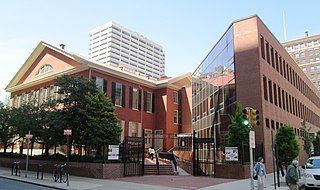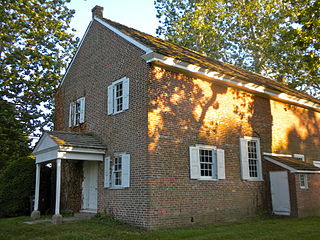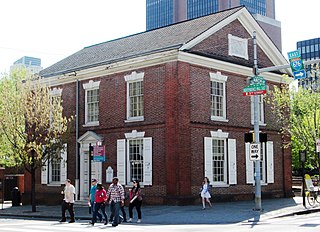
Concordville is an unincorporated community in Concord Township, Delaware County, Pennsylvania, United States. It is located 20 miles west-southwest of Philadelphia, at the junction of U.S. Routes 1 and 322. This intersection can be traced back to two of the earliest roads in Pennsylvania, Baltimore Pike which became U.S. 1, and Concord Pike, which connected Pennsylvania with Delaware.

The Race Street Meetinghouse is an historic and still active Quaker meetinghouse at 1515 Cherry Street at the corner of N. 15th Street in the Center City area of Philadelphia, Pennsylvania. The meetinghouse served as the site of the Yearly Meeting of the Hicksite sect of the Religious Society of Friends (Quakers) from 1857 to 1955.

The Friends Meetinghouse is an historic Friends Meeting House of the Religious Society of Friends (Quakers) located at the junction of Routes 146A and 98 in Uxbridge, Massachusetts. On January 24, 1974, it was added to the National Register of Historic Places.

Pipe Creek Friends Meetinghouse is a historic Friends meeting house located at Union Bridge, Carroll County, Maryland, United States. It is a 1 1⁄2-story brick structure in Flemish bond on a stone foundation. The meetinghouse was begun in 1771 and completed the next year. A fire in October 1934 destroyed the interior, but the original benches were saved. The founders of the meetinghouse were immigrants from the north of Ireland. It was the Quaker meetinghouse attended by a great-grandfather of President Herbert Hoover.

Old Town Friends' Meetinghouse, also known as Aisquith Street Meeting or Baltimore Meeting, is a historic Quaker meeting house located at Baltimore, Maryland, United States. It is a two-story brick building which has undergone several alterations over the years. It is the oldest religious building in the city, having been built in 1781 by contractor George Mathews.

The Cambridge Meetinghouse, also known locally as the Old Brick Church is a historic meetinghouse at 85 Church Street in Jeffersonville, the main village of Cambridge, Vermont. Built in 1826 as a union church for several denominations, it began use as the local town hall in 1866, a use that continued to 1958. It was listed on the National Register of Historic Places in 1981. It presently houses the local post office.

The Nine Partners Meeting House and Cemetery is located at the junction of NY state highway 343 and Church Street, in the village of Millbrook, New York, United States. The meeting house, the third one on the site, was built by a group of Friends ("Quakers") from the Cape Cod region, Nantucket and Rhode Island in 1780.

The Friends Meetinghouse and School is an historic Quaker meeting house and adjacent school building at the corner of Schermerhorn Street and Boerum Place in the Boerum Hill neighborhood of Brooklyn, New York City.

Easton Friends North Meetinghouse is a historic Quaker meeting house located at North Easton in Washington County, New York. It was built in 1838 and is a one-story, rectangular brick structure with a gable roof.

Moorestown Friends School and Meetinghouse is a historic Quaker school and meetinghouse on Main Street at Chester Avenue in Moorestown Township, Burlington County, New Jersey, United States. The Friends Meeting hosts Quaker worship every Sunday in the meetinghouse, as well as a variety of events, including Christmas Eve meeting for worship and youth activities.

Newton Friends' Meetinghouse is a historic Quaker meeting house at 808 Cooper Street in Camden, Camden County, New Jersey, United States.

Little Egg Harbor Friends Meeting House is a historic Quaker meetinghouse at 21 E. Main Street in Tuckerton, Ocean County, New Jersey, United States. The meetinghouse was built in 1863 and added to the National Register of Historic Places in 2002. Little Egg Harbor Meeting is part of Burlington Quarterly Meeting which is part of the Philadelphia Yearly Meeting. Friends continue to meet at Little Egg Harbor Meeting on Sundays at 10:30 a.m.

Alloways Creek Friends Meetinghouse is a historic Quaker meeting house on Buttonwood Avenue, 150 feet west of Main Street in Hancock's Bridge, Lower Alloways Creek Township, Salem County, New Jersey, United States.

Concord Friends Meetinghouse is a historic meeting house on Old Concord Road in Concordville, Delaware County, Pennsylvania. The meeting was first organized sometime before 1697, as the sixth Quaker meeting in what was then Chester County. In 1697 the meeting leased its current location for "one peppercorn yearly forever" from John Mendenhall. A log structure was built in 1710. The current brick edifice structure was built in 1728. After a fire which completely destroyed the interior, the meetinghouse was rebuilt and enlarged in 1788. During the Battle of Brandywine on September 11, 1777, which was fought a few miles to the west, wounded American soldiers took refuge in the meetinghouse.

The Free Quaker Meetinghouse is a historic Free Quaker meeting house at the southeast corner of 5th and Arch Streets in the Independence National Historical Park in Philadelphia, Pennsylvania. It was built in 1783, and is a plain 2 1/2-story brick building with a gable roof. The second floor was added in 1788. The building was moved about 30 feet to its present site in 1961, to allow for the widening of Fifth Street.

York Meetinghouse is a historic Quaker meeting house at 134 West Philadelphia Street in York, York County, Pennsylvania. It was built in 1766 and expanded in 1783. The original building was a two-bay brick structure with a gable roof. The addition nearly doubled the building. It is a two-bay brick structure with another entrance and window. The meeting house is still used for regular worship services.

Camden Friends Meetinghouse is a historic Quaker meeting house located on Commerce Street in Camden, Kent County, Delaware. It was built in 1805, and is a two-story, gambrel-roofed, brick building. The roof is punctuated by two shed roofed dormers. The second floor housed a school that operated from 1805 to 1882.

Appoquinimink Friends Meetinghouse, also known as the Odessa Friends Meetinghouse, is a very small but historic Quaker meetinghouse on Main Street in Odessa, Delaware. It was built in 1785 by David Wilson and added to the National Register of Historic Places in 1972. Members of the meeting, including John Hunn and his cousin John Alston, were active in the Underground Railroad and Harriet Tubman may have hid in the meetinghouse. Measuring about 20 feet (6.1 m) by 22 feet (6.7 m), it may be the smallest brick house of worship in the United States.

Friends Meetinghouse is a historic Quaker meeting house at 4th and West Streets in Wilmington, Delaware in the Quaker Hill neighborhood. The meeting is still active with a membership of about 400 and is part of the Philadelphia Yearly Meeting. It was built in 1815–1817 and added to the National Register of Historic Places in 1976.

Honey Creek Friends' Meetinghouse is an historic building located in New Providence, Iowa, United States. It was listed on the National Register of Historic Places in 1980.



























